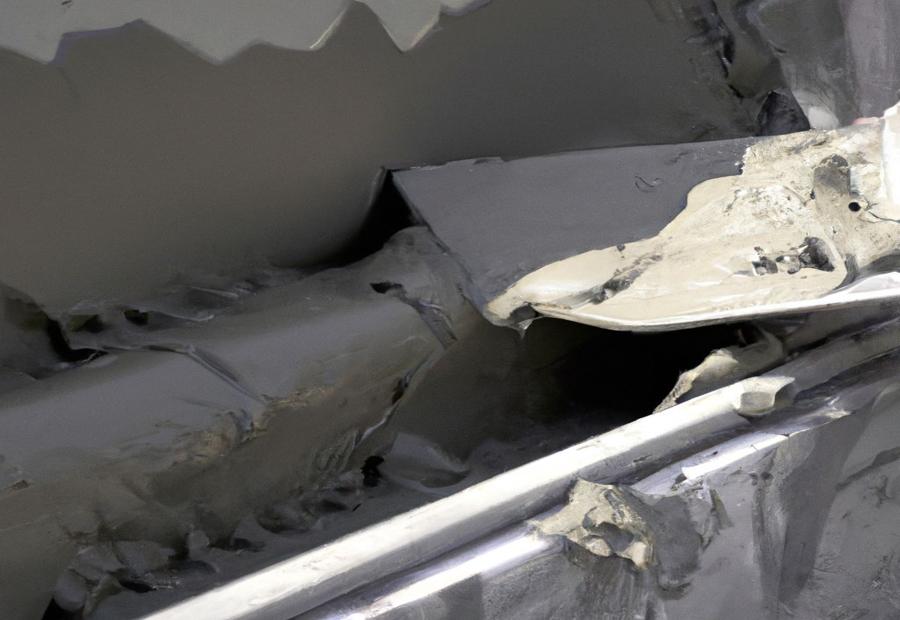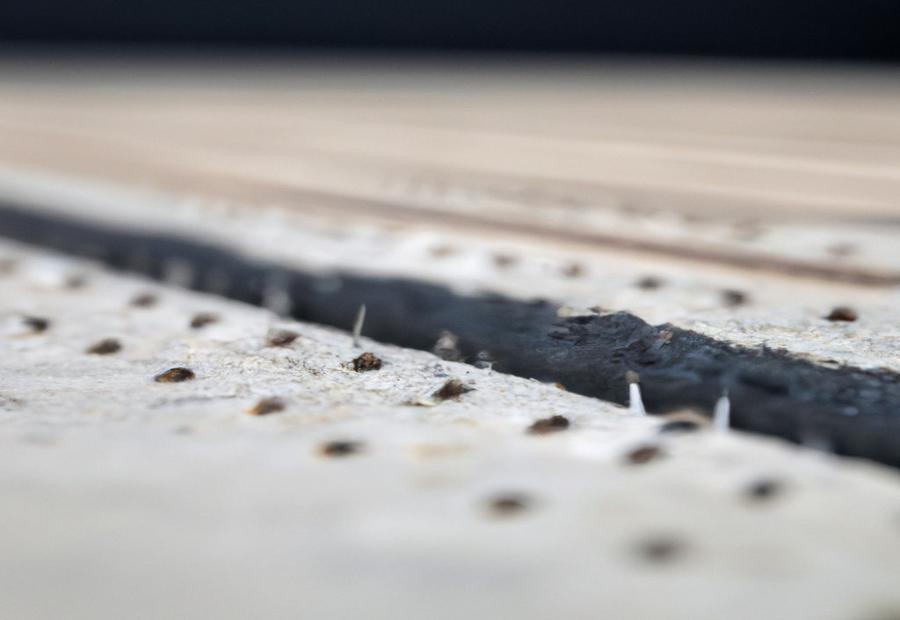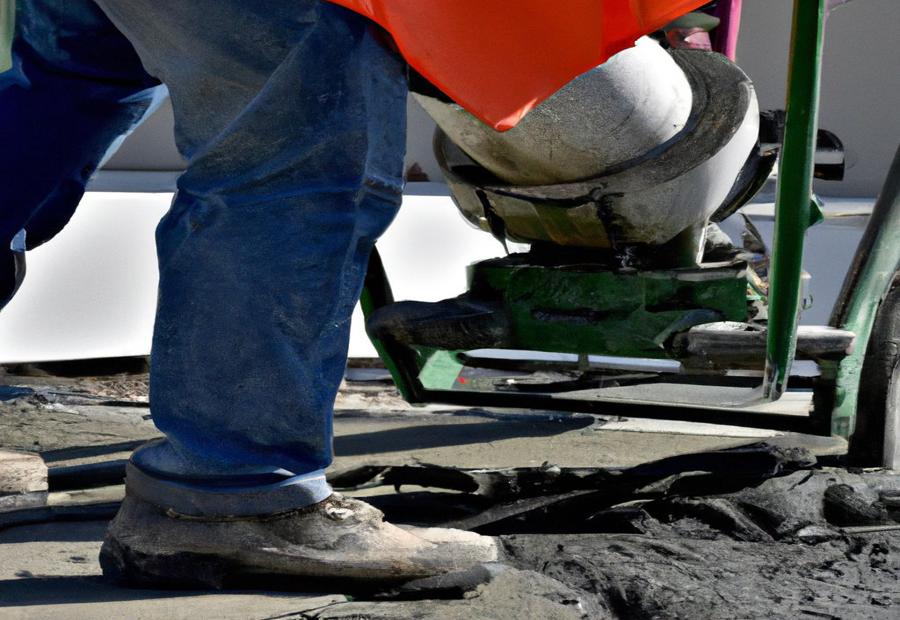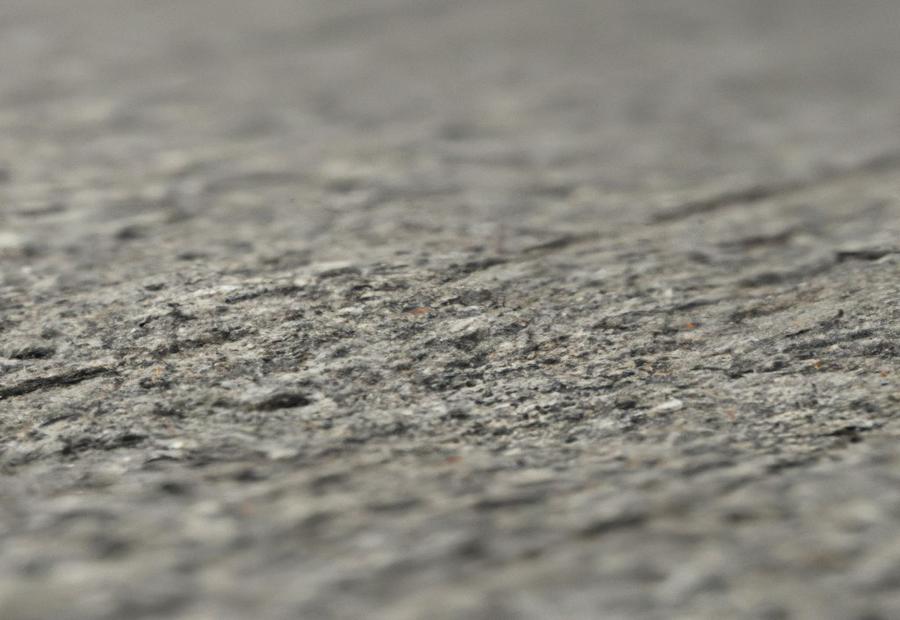.jpg)
.jpg)
.jpg)
Key Takeaways:
- Vibrating concrete properly is essential for achieving proper compaction and a smooth surface finish.
- There are different types of concrete vibrators available, including internal vibrators, surface vibrators, and vibrating roller screeds, each serving specific purposes in the concrete vibration process.
- It is crucial to use concrete vibration machinery correctly, following recommended techniques and guidelines for each type of vibrator used.



Photo Credits: Build-Wire.Com by Brian Roberts
Introduction to Concrete Vibration: Discover the crucial role of internal vibration in concrete work and explore the different types of concrete vibrators. Uncover the significance of proper concrete vibration techniques for achieving strong and durable structures. Learn how internal vibration ensures the removal of air bubbles, enhances the concrete’s density, and improves its overall strength. Delve into the world of concrete vibrators, their varying features, and how they cater to specific construction needs.
Internal Vibration and its Importance
Internal vibration is a key part of concrete compaction. It uses concrete vibrators to get rid of air bubbles. This boosts the bond between the paste and aggregates, making the material denser and more solid.
There are several benefits to internal vibration. Firstly, it raises the strength and durability of concrete structures. This lowers the risk of future cracks.
Secondly, it helps create a smoother finish. The vibrations level any bumps, giving a uniform appearance. This is great for architectural concrete or exposed aggregate finishes.
Plus, it helps with placing reinforcement materials in concrete structures. Internal vibration ensures steel bars or wire mesh stay in position. This strengthens their bond and stops them from shifting.
Conclusion: Internal vibration is essential for concrete compaction. It helps with strength, durability, surface finish and reinforcing materials. Knowing how to use it properly helps construction pros get great results.
Different Types of Concrete Vibrators
Concrete vibrators are an essential tool for concrete compaction. They come in various types, each with its own special characteristics and uses.
It’s helpful to create a table to compare features and applications of the different types. This makes it simpler for contractors to pick the best vibrator for their needs.
Here’s a table of different types of concrete vibrators:
| Type | Applications |
|---|---|
| Internal Vibrator | Consolidation of concrete inside forms |
| Surface Vibrator | Smoothing and leveling large surfaces |
| Immersion Vibrator | Proper compaction in deep and narrow forms |
| Formwork Vibrator | Vibration during precast concrete production |
| Vibrating Roller Screed | Compaction for large areas |
There could be other variations or specialized models available.
The right type of vibrator depends on factors like project size, depth, accessibility, and desired level of compaction. Contractors should think about these before choosing.
All vibrators serve the same purpose, but they differ in design, power source, frequency, and amplitude. This lets contractors adapt their selection to project requirements.
Vibrating concrete techniques are always improving to increase efficiency and productivity. New techniques have been developed to make compaction better while avoiding issues like surface damage or segregation. Correct execution is key for optimal results.
One amazing fact about vibrating concrete is that it increases strength and durability. According to Construction World, proper vibration techniques lead to a more uniform mixture and less risk of voids, for better performance.
Concrete vibration: making the ground shake and the jokes quake!
Methods of Concrete Vibration



Photo Credits: Build-Wire.Com by Roger Perez
The methods of concrete vibration are a crucial aspect of achieving proper compaction for durable structures. Surface vibrators are ideal for achieving a smooth surface finish, while immersion vibrators ensure proper compaction throughout the concrete. For large area compaction, vibrating roller screeds provide efficient and effective results. With these various methods at our disposal, we can ensure the structural integrity and longevity of concrete projects.
Surface Vibrators for Smooth Surface
Surface vibrators are essential for a smooth concrete finish. Placement, selection, and technique are crucial for proper compaction and consolidation.
Here are some steps to follow for using surface vibrators:
- Place them strategically, covering the entire surface.
- Select the right type of vibrator with sufficient power and frequency.
- Insert the vibrator vertically at regular intervals, slowly withdrawing and reinserting.
- Poor use or excessive vibration can lead to segregation or bleeding, so follow manufacturer guidelines for best results.
Don’t accept a half-baked concrete finish – immerse yourself in success with immersion vibrators!
Immersion Vibrators for Proper Compaction
Immersion vibrators are widely used to ensure proper compaction of concrete. These vibrators are inserted into the mixture to remove trapped air and spread material evenly. This is vital for a strong and durable result.
Different types of vibrators exist, each with unique characteristics. Internal vibrators are used in confined spaces like walls and columns. They connect to an electric motor via a flexible shaft. Pencil vibrators are like internal ones but with smaller diameters. They are used for small projects or touch-ups. Plate vibrators have a flat plate pressed onto the surface of the concrete. They are great for floor slabs and pavements. Lastly, trench vibrators are used for deep foundations and can reach depths of 6 meters and more.
The power source and vibration frequency of immersion vibrators also vary. Some run on electricity, others on gasoline or air pressure. Frequency can range from 6,000 to 12,000 vibrations per minute.
When using these vibrators, make sure they are immersed at regular intervals. Check the motor and shaft regularly. Adjust the duration and depth of immersion according to the mix and project requirements. Finally, follow the manufacturer’s guidelines and safety precautions for safe operation.
Vibrating Roller Screeds for Large Area Compaction
Vibrating roller screeds are an essential tool for compaction in large concrete spaces. They use vibration to make it even. Contractors can use these machines to save time and money, while still getting the job done right.
- Vibrating roller screeds make the surface smooth and even across wide areas.
- They are greater than traditional vibrators in difficult, less accessible areas.
- Using them reduces labor costs and increases productivity.
- They are ideal in places like highways, runways, and large industrial projects.
Vibrating roller screeds are the way to go for large projects. They reduce time and effort for compaction over large areas. This advanced tech makes sure the project is quality and long-lasting.
The art of concrete vibration is using the machine correctly to get the job done.
Proper Use of Concrete Vibration Machinery



Photo Credits: Build-Wire.Com by Daniel Robinson
When it comes to achieving optimal concrete vibration, it is essential to understand the proper use of vibration machinery. In this section, we will dive into the benefits and techniques of using internal vibrators for consolidation and formwork vibrators for precast concrete. Discover how these tools can enhance the structural integrity and overall quality of your concrete projects, backed by reliable data from industry experts.
Internal Vibrator for Consolidation
Internal Vibrators for Consolidation are essential tools for achieving proper compaction and consolidation of freshly poured concrete. They are specifically designed to be inserted into the concrete and vibrate, removing air or excess water. This helps create a strong, durable finished product.
These vibrators come in various sizes and designs. Handheld models are electrically powered. Larger models are attached to an external power source. They have a long shaft with an eccentric weight at the end. When the weight rotates at high speed it creates vibrations. These vibrations make the cement paste flow between aggregate particles, eliminating voids and improving quality.
Internal Vibrators offer more benefits. They help prevent segregation by mixing components. They reduce friction to improve workability. They also improve bond strength and ensure adhesion with reinforcement bars or formwork surfaces. Finally, they can be used to remove air bubbles.
However, Internal Vibrators should be used correctly to avoid potential issues or damage. Proper positioning is key to ensure complete coverage and avoid empty pockets or inadequate consolidation.
Overall, Internal Vibrators are essential tools for achieving proper compaction and consolidation of freshly poured concrete. They contribute to improved strength, durability, and quality. It is essential to use them correctly and follow recommended practices to achieve desired results.
Formwork Vibrators for Precast Concrete
Formwork vibrators are essential for producing high-quality precast concrete products. They help create a dense, homogenous finish by eliminating air bubbles and pockets. Different forms of vibrators are used to achieve various goals. Internal or immersion vibrators ensure uniform compaction. Surface vibrators provide a smooth finish. Roller screeds are great for large area compaction.
These vibrators offer flexibility for different project requirements. In addition, they enhance productivity by reducing curing time and enabling faster demolding. This leads to quicker turnaround times. And, they minimize material wastage.
In summary, formwork vibrators are like dance moves at a party. They are indispensable for finding the right rhythm and keeping everything shaking in the right place.
Caution and Recommendations for Concrete Vibration



Photo Credits: Build-Wire.Com by Benjamin Allen
When it comes to vibrating concrete properly, there are crucial precautions and recommendations to keep in mind. From ensuring the proper positioning of vibrators to managing excess water and air bubbles, this section offers valuable insights. We’ll also dive into the expert recommendations from Build Magazine and explore strategies for dealing with equipment problems. It’s time to equip yourself with the knowledge necessary to achieve optimal concrete vibration results.
Proper Positioning of Vibrators
Vibrator positioning plays an essential role in concrete vibration for effective compaction and consolidation. Locate the vibrator at strategic points in the concrete for optimal results. Here is a 3-Step Guide:
- Identify key areas – corners, edges, obstructions like reinforcement bars. Vibrations should be evenly dispersed.
- Figure out the depth of insertion, based on concrete slump and thickness. Vibrator must reach the desired depth.
- Move in a systematic pattern with overlapping strokes. Avoid staying in one spot too long. Maintain a consistent speed with structural members or formwork.
Additional Details:
Correct positioning of vibrators will minimize voids and air pockets in the concrete mix. It enhances the strength and durability of structures. Research has shown that improper positioning of vibrators can lead to inadequate consolidation, weakening structures and increased maintenance costs over time. Build Magazine’s recommendations are shaking up the industry.
Recommendations from Build Magazine
Build Magazine offers valuable advice for concrete vibration techniques. These tips serve as guides for the construction industry to guarantee successful and efficient compaction.
- Correct Placement of Vibrators: Build Magazine suggests the correct positioning of vibrators for ideal consolidation results. This involves placing the vibrator at specific distances along the length and width of the concrete shape.
- Handling Excess Water and Air Bubbles: The magazine emphasizes the significance of controlling the water-cement ratio and reducing air entrainment in concrete. This helps to stop extreme bleeding, segregation, and honeycombing.
- Fixing Equipment Problems: Build Magazine provides solutions and troubleshooting tips for common equipment troubles related to concrete vibration. These consist of handling motor malfunctions, keeping proper lubrication, and making sure adequate power supply.
These tips from Build Magazine are important for improving the quality and strength of concrete structures. Following these guidelines can help construction experts prevent potential issues such as inadequate compaction, poor surface finish, and structural weaknesses.
Additionally, it is essential to note that each project has unique demands and challenges when it comes to concrete vibration. Thus, it is suggested to consult relevant specialists or seek professional advice tailored to particular construction scenarios.
By using Build Magazine’s advice in their concrete vibration procedures, industry professionals can boost overall construction efficiency, strengthen concrete strength and durability, and make sure the endurance of structures.
Managing excess water and air bubbles in concrete can be a real headache, but with the proper techniques, you can make them vanish without making too much of a fuss.
Managing Excess Water and Air Bubbles
Excessive water and air bubbles in concrete can harm its strength and durability. To ensure the quality of the finished product, proper management of these factors is essential.
Here’s a 6-step guide to do so:
- Use the right concrete mix. Select one that is designed to minimize water content and maximize workability without compromising strength.
- Thoroughly mix all components – aggregates, cement, water, and additives or admixtures – for uniform hydration and compaction.
- When pouring or placing the concrete, use proper techniques to prevent segregation and entrapment of air bubbles. Avoid dropping it from excessive heights or allowing it to flow freely over obstructions.
- Use internal vibrators or surface vibrators to compact the concrete and eliminate trapped air bubbles. Vibrate in a systematic pattern for complete consolidation and uniform compaction.
- Maintain optimal curing conditions. Protect freshly placed concrete from rapid evaporation, extreme temperatures, and excessive moisture loss. This will help to minimize shrinkage cracks.
- Regularly test fresh and hardened concrete for various properties such as slump, air content, compressive strength, etc.
It’s important to note that managing excess water and air bubbles requires knowledge, skill, experience, and attention to detail. By following these steps consistently, contractors can prevent issues. Communication and coordination between project team members are also essential. Proper planning, execution, and monitoring of concrete-related activities can lead to the desired end result of a strong, durable, and aesthetically pleasing concrete structure.
Dealing with Equipment Problems
Identifying equipment malfunctions is key in proper concrete vibration. Anomalies, such as unusual noises, signs of wear and tear, or any irregularities in the equipment’s performance can lead to inefficiencies and bad results. So, resolving these issues swiftly is essential. This may include repairing/replacing parts, adjusting settings, or seeking professional advice.
Moreover, regular maintenance is necessary for optimal performance and extended lifespan of vibrating equipment. This includes cleaning, lubricating, and inspecting machinery, in accordance with manufacturer’s guidelines.
Also, a stable power source is vital to avoid power supply or voltage fluctuations. Plus, staff responsible for operating vibrating machinery should be properly trained to understand how the equipment functions and to know best practices for its use.
Finally, monitoring equipment behavior and performance can help detect potential problems quickly. This way, contractors can take proactive measures, minimize disruptions, maintain project timelines, and ensure quality in the final product.
Latest Data on Vibrating Concrete Properly



Photo Credits: Build-Wire.Com by Albert Hill
Concrete vibration is a vital aspect of construction, ensuring structural integrity and durability. In this section, we will explore the latest data and techniques for vibrating concrete properly. From expert insights to various approaches, we delve into what makes concrete vibration effective. So, whether you’re seeking guidance on construction world’s concrete vibration techniques or looking to execute it properly, this section provides essential information for a successful concrete project.
Concrete Vibration Techniques from Construction World
Construction World suggests various methods of concrete vibration to ensure proper strength and durability of structures. Here’s a 6-step guide to understand and implement these techniques:
- Internal Vibrator Selection: Select the appropriate vibrator according to the size and depth of the element. Internal vibrators are common for compaction, ensuring uniform aggregates and air void removal.
- Proper Placement: Place the internal vibrator at regular intervals along the formwork. This helps in reaching optimal compaction and reducing the risk of weak areas.
- Vibration Technique: Insert the vibrator vertically into the concrete at predefined points. Move it down gradually as compaction progresses. Maintain a consistent speed. Avoid touching or dragging against reinforcement or formwork.
- Duration of Vibration: Vibrate each insertion point until no air bubbles rise to the surface. Duration may vary depending on factors such as temperature and formwork.
- Surface Finishing: After internal vibration, use surface vibrators for a smooth finish on exposed surfaces. They can also be used for thin slabs or shallow sections.
- Quality Control: Monitor the process for uniformity in vibration techniques and workmanship. Conduct tests such as slump tests or air content tests.
It’s important to note that each project may have unique requirements. Consulting with design professionals and referring to industry guidelines is necessary. Preparation, use of right equipment and water/air bubble management are key for successful concrete vibration practices.
Different Approaches to Concrete Vibration
Concrete vibration techniques can be categorized into different approaches for optimal compaction. These involve the use of vibrators and equipment for a purpose.
- Internal Vibration: Also called immersion or poker, these are inserted into wet concrete to remove air and ensure compaction.
- Surface Vibration: Used to obtain a smooth surface finish. Placed on the concrete, vibrations help level and finish it.
- Formwork Vibration: Designed for precast concrete. Attached to formwork and provide vibrations for placement and consolidation.
- Vibrating Roller Screeds: Primarily used for large area compaction. A vibrating tube or drum is rolled over freshly poured concrete.
- Different Techniques: Execution may vary according to factors like project requirements and desired results. This could include internal consolidation, external vibration, or combination methods.
- Proper Execution: To get optimal results, techniques and guidelines must be followed. This includes positioning the vibrator, managing air bubbles, addressing any equipment issues, and following expert recommendations.
In conclusion, concrete vibration techniques vary based on needs and desired results. Using vibrators like internal, surface, formwork, and vibrating roller screeds, effective compaction can be achieved for strength and durability. Proper execution is essential.
Proper Execution of Concrete Vibration
For proper concrete vibration, try the following steps:
- Positioning: Insert the internal vibrator vertically, away from formwork and reinforcement. This allows even vibrations throughout the mix.
- Vibrator Selection: Choose the right type based on concrete size and thickness. This boosts efficiency.
- Duration and Frequency: Maintain the same duration and frequency. This eliminates air voids and increases strength.
- Withdrawal: Gradually withdraw the vibrator to prevent mix segregation.
Plus, start vibration quickly after pouring. Monitor water content in the mix too. Manage air bubbles with additives or adjust mixture proportions.
To sum up, proper execution of concrete vibration is vital for high-quality structures, free from defects and lasting long.
Some Facts About How To Vibrate Concrete Properly:
- ✅ Concrete vibration helps eliminate voids in the mixture and make the concrete more dense and homogeneous. (Source: Team Research)
- ✅ There are two methods of vibrating concrete: internal and external. (Source: Team Research)
- ✅ Proper machinery, such as vibrating needles or external vibrators, should be used for concrete vibration. (Source: Team Research)
- ✅ The vibrating needle should be inserted vertically and quickly, reaching the desired depth, and removed at an inclined angle to avoid surface marks. (Source: Team Research)
- ✅ Each vibration should overlap the previous one to create a homogeneous mixture, taking into account the vibrator’s radius of action. (Source: Team Research)
FAQs about How To Vibrate Concrete Properly
How should a vibrating needle be introduced vertically into the concrete mixture?
To achieve a good result, a vibrating needle should be introduced vertically into the concrete mixture. It should be inserted quickly to the desired depth and then removed at an inclined angle to avoid surface marks.
What is the risk factor associated with using a quick vibration technique during concrete vibrating?
Using a quick vibration technique can lead to structural failure in the concrete. It is important to vibrate the concrete slowly and steadily to ensure proper compaction and avoid any potential issues.
How can cold joints be prevented during the concrete vibrating process?
To prevent cold joints, it is recommended to place the vibrating needle at least 6 inches into the previous layer of concrete. This ensures a proper bond between the layers and helps to avoid any weak points in the structure.
What is a lightweight portable vibrator and when should it be used?
A lightweight portable vibrator is a type of concrete vibrator that is easy to carry and maneuver. It is recommended for use in situations where a single person needs to vibrate the concrete, or in construction sites where mobility and versatility are important.
What should be done when compaction is complete during concrete vibrating?
When compaction is complete, the vibrating process should be stopped. This can be determined by observing the surface of the concrete. If no air bubbles are forming and a sheen surface is obtained, then compaction is considered complete.
How can aesthetic issues be avoided during concrete vibrating?
To avoid aesthetic issues, such as an inconsistent surface finish, it is important to vibrate the concrete in a regular pattern. This helps to evenly distribute the concrete and achieve a smooth and visually appealing finish.